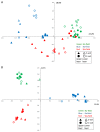Comparison of Prokaryotic and Eukaryotic Communities in Soil Samples with and without Tomato Bacterial Wilt Collected from Different Fields
- PMID: 29187707
- PMCID: PMC5745023
- DOI: 10.1264/jsme2.ME17131
Comparison of Prokaryotic and Eukaryotic Communities in Soil Samples with and without Tomato Bacterial Wilt Collected from Different Fields
Abstract
Biocontrol agents (BCA) effectively suppress soil-borne disease symptoms using natural antagonistic prokaryotes or eukaryotes. The main issue associated with the application of BCA is that disease reduction effects are unstable under different field conditions. In order to identify potentially effective BCA among several fields, we compared prokaryotic and eukaryotic communities in soil with and without tomato bacterial wilt from three different fields, each of which had the same field management and similar soil characteristics. Soil samples were collected from three fields and two depths because bacterial wilt pathogens were present in soil at a depth greater than 40 cm. We classified soil samples based on the presence or absence of the bacterial phcA gene, a key gene for bacterial wilt pathogenicity and tomato disease symptoms. Pyrosequencing of the prokaryotic 16S rRNA gene and eukaryotic internal transcribed spacer region sequences showed that the diversity and richness of the communities mostly did not correlate with disease symptoms. Prokaryotic and eukaryotic community structures were affected more by regional differences than the appearance of disease. Several prokaryotes and eukaryotes were more abundant in soil that lacked disease symptoms, and eight prokaryotes and one eukaryote of this group were commonly detected among the three fields. Some of these taxa were not previously found in disease-suppressive soil. Our results suggest that several prokaryotes and eukaryotes control plant disease symptoms.
Keywords: 454 pyrosequencing; Ralstonia solanacearum; biocontrol agent; deep layer of soil; indicator species analysis.
Figures


References
-
- Atkins S.D., Clark I.M., Sosnowska D., Hirsch P.R., Kerry R.R. Detection and quantification of Plectosphaerella cucumerina, a potential biological control agent of potato cyst nematodes, by using conventional PCR, real-time PCR, selective media, and baiting. Appl Environ Microbiol. 2003;69:4788–4793. - PMC - PubMed
-
- Castillo J.D., Lawrence K.S., Klopper J.W., van Santen E. Evaluation of Drechslerella dactyloides, Drechslerella brochopaga, and Paecilomyves Lilacinus for biocontrol of Rotylenchulus reniformis. Nematropica. 2010;40:71–85.
MeSH terms
Substances
LinkOut - more resources
Full Text Sources
Other Literature Sources

